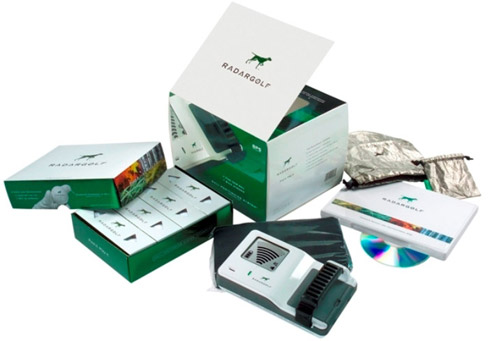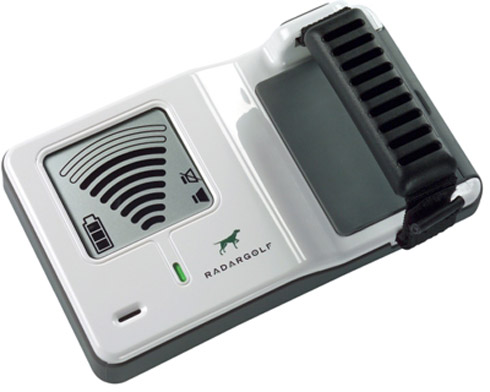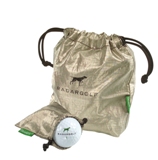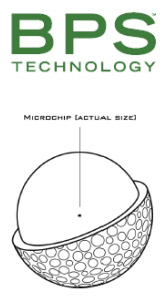 Play golf and you will quickly learn that a golf ball can and will find a place to hide from you. Play enough golf and you will spend a lot of time hunting down golf balls for yourself, your friends, and groups on neighboring holes.
Play golf and you will quickly learn that a golf ball can and will find a place to hide from you. Play enough golf and you will spend a lot of time hunting down golf balls for yourself, your friends, and groups on neighboring holes.
Creating an easily findable golf ball is not the newest idea on the market. In fact, patents for similar “innovations” date back to 1925. However, we live in the 21st century, and the RadarGolf System is currently the leader.
I was able to spend some time with a RadarGolf system which promises to lower your scores and raise you enjoyment but the real question is, will you ever lose another golf ball again? Read on to find out…
RadarGolf
Based in the Bay Area in Roseville, CA, RadarGolf was founded in 2002 by Chris Savarese. The concept was one he’d had in his mind for ten years. Though Savarese says that “our target market is anyone caring about lowering their scores,” he later adds that “playing our ball is potentially a stroke-, frustration- and time-saver.” Add to that the potential savings of not losing today’s fairly expensive golf balls, and you have what seems to be a winner on your hands.
The stroke-saving concept is simple enough: if you don’t lose your ball, you can’t be assessed penalty strokes. Finding your ball quickly also understandably saves time and frustration. If you’ve ever had to play the “leaf rule,” you can relate to the frustration of looking in the area where your ball should be and not finding it.
With the RadarGolf System, you can quickly locate your ball if you know the general area in which it came to rest. Take myself for example. I often play golf by myself and suffer from poor vision, so on a new course with very thick rough or a lot of bushes, I can spend a couple minutes every hole searching for my ball. I’ve joked with friend and family that I’ve lost more golf balls because of my bad vision than I have from bad shots but it’s probably true. I like to play the game quickly and become frustrated if I have to spend more than a minute searching for my ball. Often, I’ll give up for the sake of time and drop a new ball.
How It Works
Unlike some silly golf-ball finding glasses, the RadarGolf System uses radar (go figure) to locate balls. A hand-held unit transmits a radio frequency in a bean pattern. The special RadarGolf balls have an embedded microchip that bounces the signal back to the hand-held unit, which audibly and visually alerts the golfer when they’re close to their ball.
If that sounds confusing, don’t worry – the system comes with a DVD that explains and demonstrates the proper way to complete a search with the handheld.
The RadarGolf System
Though the RadarGolf website has pictures of the device, I wasn’t sure what to expect. I had daydreams of carrying around a little metal detector like those frugal old men that wander the beach in search of lost nickels. Instead, I found a small handheld unit, some balls, some special pouches, and a DVD.

The RadarGolf System includes a handheld, a carrying case, a large and small Shield-it pouch, one dozen RadarGolf balls and instructional DVD.
The handheld unit (larger image below) is about twice the size of some handheld range finders and fits quite easily into your golf bag. It was designed for outdoor use (duh) and I also discovered after dropping it that it is very durable. The unit is water resistant should you accidentally spill your favorite beverage on it or use it the rain. Unfortunately, the RadarGolf System is unable to find balls lost in the water, so you’ll have to continue to rely on a keen eye and your retractable ball retriever for that.
The unit has three buttons to keep things simple: one power and two volume control buttons, all of which are rubber coated for dependability. The alarm can also be adjusted to different volume levels or completely muted if you like. The handheld unit also comes with an adjustable strap that goes around your hand, and it too is durable enough to years of use.
One final feature of the hand-held unit: after turning it on, the unit will automatically turn off after five minutes. This is the same amount of time allowed by the USGA Rules of Golf to search for lost balls.

The RadarGolf Handheld measures roughly 4 x 7 x 2 inches and can sniff out a ball within a range of 30-100 feet.
Finally, the protective case is made of nylon, fits like a glove, and with its three-quarter style zipper, slips easily on and off the handheld. It also has a clip on it to attach to your bag or cart.
Shield-it Pouches
 The RadarGolf System comes with some space-age looking bags that seem more suitable for an astronaut than a golfer, but their use is quite important. Think about it: you buy a dozen RadarGolf balls, put them in your bag, and drive to the area where you think your ball should be. The hand-held unit locks onto a signal and walks you straight over to the 11 balls still remaining in your bag!
The RadarGolf System comes with some space-age looking bags that seem more suitable for an astronaut than a golfer, but their use is quite important. Think about it: you buy a dozen RadarGolf balls, put them in your bag, and drive to the area where you think your ball should be. The hand-held unit locks onto a signal and walks you straight over to the 11 balls still remaining in your bag!
Yes, the Shield-it Pouches are made of a special metallic fabric that shields or masks the chips inside RadarGolf balls in your bag or pants pockets from the radio signal transmitted by the hand-held unit.
The system comes with a larger pouch that will store up to a dozen and a smaller pouch will only hold one ball (for your pocket). The pouches have a draw string closure and won’t take up any extra room in your golf bag. In fact, I liked having the large pouch just for the extra golf ball since my stand bag doesn’t have very many pockets to begin with.
The Ball
 The final piece of the whole package is the ball itself. The RadarGolf ball has a tiny microchip embedded in the core of the ball that bounces the signal sent by the hand-held unit back to the unit. This signal gets stronger the closer you get to the ball, and the hand-held unit displays more bars and the tone gets louder.
The final piece of the whole package is the ball itself. The RadarGolf ball has a tiny microchip embedded in the core of the ball that bounces the signal sent by the hand-held unit back to the unit. This signal gets stronger the closer you get to the ball, and the hand-held unit displays more bars and the tone gets louder.
The RadarGolf ball is a two-piece, low-compression ball with an ionomer cover. It’s very similar in construction and design to your typical two-piece ball, and a dozen will set you back $39.95. The ball, though not up to the performance of the TaylorMade TP Balls, the Titleist Pro V1x, the Nike ONE, etc. But let’s be honest: golfers who should be playing those balls aren’t looking for their ball in the bushes on every hole, either. This ball is far and away better than the “Rock Flites” of old and compares with the Titleist NXT, Callaway HX Hot, Maxfli Noodle, and other $19.99/dozen balls available on the market. This should satisfy the masses who may not need a multi-layer ball.
Off the driver, I didn’t notice that much of a loss or gain of distance, but the ball did feel firmer feel than I’m used to. Spin on woods, hybrids, and long irons was controlled enough not to balloon shots and reacted like a typical two-piece ball. The same feeling and performance could be found on chips, full-, and half-wedge shots where you can’t expect a lot of spin out of the ball but it will perform consistently for you. Practicing on the chipping and putting greens I liked the way the ball flew and landed, I liked how consistent the ball seems to fly and carry with my irons. Another thing I appreciate with these balls is the durability on full wedge shots and those few errants shots that bounced on a cart path or landed in the desert. All held up well with minimal scratches or discoloration.
Now I know some of you may be die hards and are very loyal to the ball you play. Don’t worry, as there is still hope for you. RadarGolf has plans to add its chips to brand-name balls soon. They hope to have their first licensing deal by the end of the year.
The Rules
An FAQ on the RadarGolf site tells you all you need to know about whether this thing is legal or not:
Is the RadarGolf Ball a USGA-conforming ball?
Yes. The RadarGolf Ball meets all USGA criteria for size, weight, distance, initial velocity and symmetry.Does the RadarGolf System conform to USGA rules?
The USGA states that scores may still be submitted for handicap purposes since the RadarGolf System does not assist in the physical execution of the golf stroke. Therefore, the RadarGolf system is allowed for posting USGA handicaps.
In other words, you won’t be using the system in any competitions, but the ball itself is legal.
Does It Actually Work?
 Convincingly, yes. To perform the search you hold the handheld at arms length and. similar to a metal detector, gently wave the unit from side to side and from waist height to ground level. The instructions also recommend that you rotate the handheld as you walk to help spread the beam.
Convincingly, yes. To perform the search you hold the handheld at arms length and. similar to a metal detector, gently wave the unit from side to side and from waist height to ground level. The instructions also recommend that you rotate the handheld as you walk to help spread the beam.
As long as you have a general idea where your ball went you will have good success with finding your ball. I had a couple of my friends purposely “lose” a ball in thick brush, ruts and the occasional gopher hole. Then it was up to me to find my Easter egg, err golf ball. After a while it got to be real bore finding the golf ball because the system works so well the search ends fairly quickly – unless the ball was in water or near a sprinkler control box, it was easy to find.
The instructions on the DVD alert you to certain precautions when turning on the hand-held unit, such as being clear of the cart, sprinkler control boxes, and other electrical components. However, in my testing, these never posed much of a problem. Most importantly, of course, is that all of the extra RadarGolf balls be in their electromagnetically sealed pouches.
Conclusion
Though I’m not one to put a price on my time and frustration, I do know that $249.95 can buy a lot of brand-name golf balls. While I was initially hesitant to try a new ball with a microchip inside and to wander around golf courses with a beeping, flashing hand-held unit, I came away impressed with the construction, quality, and usefulness of the RadarGolf System.
Unfortunately for some, the biggest problem right now is the ball: there’s one model and if you’ve found a ball you like, the RadarGolf ball may not fit your personal preference or game. Once RadarGolf can get its chip into more name-brand balls it should take another leap and bound in gaining acceptance with the masses.
It’s still too early for me to say whether I’ll keep using the system after my initial twelve balls become too scuffed to play, but I’m fairly certain it won’t be because I’ve lost them!

Nice review, however (IMHO) I think the price and the fact that it’s not allowed in the competitions will more or less kill it. I don’t think ball manufacturers will ever make balls with chips in them – after all they live off golfers losing their balls 😉
I imagine that the time savings, the stroke savings and headache savings will be quite beneficial. Golf ball makers live off of golfers playing “their” ball, period. Balls will still be lost or worn and need to be replaced.
These units are now about $200 brand new from online stores and eBay (and even less if you buy a used one); I bought a used one and it works fairly well, but you really DO have to shield the other balls well (I tried aluminum foil and that works as well), and it picks up my beeper and cell phone, so I have to leave them in the car or park the cart away from where I’m searching. I’ve found that the balls roll forever, so trying to put backspin or getting them to check up on a hard green is futile. Distance is respectable, putting is tricky (because of the roll), and the lack of spin has its benefits sometimes. It would be great if other balls were available, but as of 04/07 I’ve heard of no other alternatives.
The dozen-ball box that the balls come in is also shielded.
I’ll be buying one of these systems for sure, my eye sight isn’t too good & this technology is a perfect solution.
This will take off in a big way if other manufacturers can implant the chip. However, I think the supplied balls will be fine (I’ll just use them for my long game, then once on the green replace it with a softer ball for putting)
Is RadarGolf available in Europe? The manufacturer only ships the product to Canada and the US.
Great review, I have just purchased the system and can’t wait to receive it and try it. I too will be a happy camper if Radargolf do end up installing there chip into some of the bigger name brand balls that I am used to using.
My ‘low vision’ specialist is an avid golfer. He advised me to get Radar Golf.
Mark, you said you would switch to another ball around the hole. Is that allowable?
Hi Wendy,
Actually I don’t think they’re even allowing these balls to be used in competition… However – for casual play it’s absolutely ok. As for replacing the ball, its a similar situation (definitely not allowed during competitions, but ok during casual play if your friends/partners are ok with it) 🙂
I am sorry to be a downer but in general I am highly disappointed with the radar golf system. It scans a large area but if there is a tree or a hill around the ball the system really struggles to find the ball. Thicker grass really hurts the system. You still need to have a pretty darn good idea where the ball is for it to work at all. I mean it does help every so often. I have read so many fantastic reviews and honestly I just want to say this because it is not as amazing as it should be. Because by the time it starts to pick up any better single you can usually see it before it does.
I bought one a few months ago to use in England. The first from Ebay stopped working after a couple of weeks and I couldn’t return it as I wasn’t the original purchaser so no warranty! The second one has a very short range and you have to be almost on top of the ball before it starts beeping. Its good if you lost the ball in long rough and you know almost exactly where it is, otherwise its not much use. I have lost about 8 of the balls in the last month.
i echo the last 2 reviews, you have to basically be on top of the ball for this thing to find it. in concept, a great idea, in practice, abysmal.
Thank you for providing very useful info like this!!, I really support your opinion, and don’t forget to visit my website too